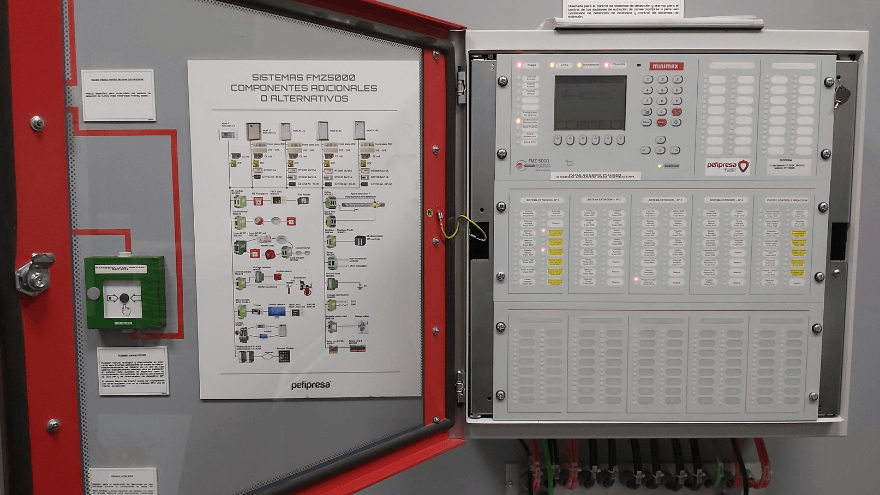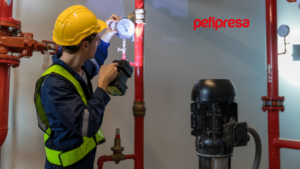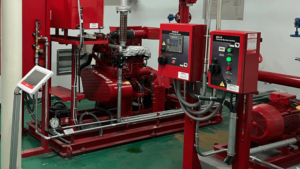Before going into the differences, we will see what is a installation of a fire detection system, the current applicable regulations and what is a conventional system and an analogue one.
Conventional and analog fire detection systems
What is a fire detection system
A fire detection and alarm system is a set of electronic equipment installed in a building or construction to detect the presence of smoke or incipient fire inside it as quickly as possible, proceeding to activate it. of different mechanisms, such as warning through visual and/or acoustic signals, or acting on other auxiliary elements, with the aim of communicating and reporting the incident and thus proceeding to extinguish or suppress it, minimizing as much as possible the possible consequences of the incident. fire.
There are different types of fire detection systems and different technologies that are used in all types of buildings, homes or industrial buildings.
When it comes to fire protection, electronic detection and alarm systems are a crucial part of any commercial building or structure. They inform and alert the occupants of the presence of fire and thereby help to reduce risks, avoiding the sinister deterioration of property and even reducing possible injuries and loss of human life. Without them, many people would not be aware, due to a lack of adequate information, that a fire has started and they might not have time to make the appropriate decisions to safeguard their integrity.
Current fire detection regulations in Spain UNE 23007 and UNE-EN 54
The current regulations that must be complied with for the design, installation and maintenance of a fire detection system in Spain are UNE 23007 and its international equivalent UNE-EN 54, with its different parts:
NORM | DATE | TITLE | STATUS AT 03/2023 |
|---|---|---|---|
UNE-EN 54-1:2022 | 2022-02-23 | Sistemas de detección y alarma de incendio. Parte 1: Introducción. | CURRENT |
UNE 23007-2:1998 | 2022-06-01 | Sistemas de detección y de alarma de incendios. Parte 2: Equipos de control e indicación. | CURRENT |
UNE-EN 54-3:2016+A1:2019 | 2019-10-23 | Sistemas de detección y alarma de incendios. Parte 3: Dispositivos de alarma de incendios. Dispositivos acústicos. | CURRENT |
UNE 23007-4:1998/2M:2007 | 2007-12-12 | Sistemas de detección y de alarma de incendios. Parte 4: Equipos de suministro de alimentación. | CURRENT |
UNE-EN 54-5:2017+A1:2019 | 2019-07-10 | Sistemas de detección y alarmas de incendios. Parte 5: Detectores de calor. Detectores de calor puntuales. | CURRENT |
UNE 23007-6:1993 | 2003-07-01 | Componentes de los sistemas de detección automática de incendios. Parte 6: Detectores térmicos. Detectores termovelocimétricos puntuales sin elemento estático. | CANCELED |
UNE-EN 54-7:2019 | 2019-10-16 | Sistemas de detección y alarma de incendios. Parte 7: Detectores de humo. Detectores puntuales de humo que funcionan según el principio de luz difusa, luz transmitida o ionización. | CURRENT |
UNE 23007-8:1993 | 2003-07-01 | Componentes de los sistemas de detección automática de incendios. Parte 8: Detectores de calor con umbrales de temperatura elevados. | CANCELED |
UNE 23007-9:1993 | 2003-07-01 | Componentes de los sistemas de detección automática de incendios. Parte 9: Ensayos de sensibilidad ante hogares tipo. | CANCELED |
UNE-EN 54-10:2002/A1:2007 | 2007-12-19 | Sistemas de detección y alarma de incendios. Parte 10: Detectores de llama. Detectores puntuales. | CURRENT |
UNE-EN 54-11:2001/A1:2007 | 2007-12-19 | Sistemas de detección y alarma de incendios. Parte 11: Pulsadores manuales de alarma. | CURRENT |
UNE-EN 54-12:2019 | 2020-12-10 | Sistemas de detección y alarma de incendios. Parte 12: Detectores de humo. Detectores de línea que usan un haz óptico de luz. | CURRENT |
UNE-EN 54-13:2019+A1:2021 | 2021-01-20 | Sistemas de detección y alarma de incendios. Parte 13: Evaluación de la compatibilidad de los componentes de un sistema. | CURRENT |
UNE 23007-14:2014 | 2014-01-15 | Sistemas de detección y alarma de incendios. Parte 14: Planificación, diseño, instalación, puesta en servicio, uso y mantenimiento. | CURRENT |
UNE-EN 54-16:2010 | 2010-07-21 | Sistemas de detección y alarma de incendios. Parte16: Control de la alarma por voz y equipos indicadores. | CURRENT |
UNE-EN 54-17:2007 | 2009-04-22 | Sistemas de detección y alarma de incendios. Parte 17: Aisladores de cortocircuito. | CURRENT |
UNE-EN 54-18:2007 | 2009-04-22 | Sistemas de detección y alarma de incendios. Parte 18: Dispositivos de entrada/salida | CURRENT |
UNE-EN 54-20:2007/AC:2009 | 2009-05-27 | Sistemas de detección y alarma de incendios. Parte 20: Detectores de aspiración de humos | CURRENT |
UNE-EN 54-21:2007 | 2007-12-19 | Sistemas de detección y alarma de incendios – Parte 21: Equipos de transmisión de alarmas y avisos de fallo | CURRENT |
UNE-EN 54-22:2016+A1:2021 | 2021-01-20 | Sistemas de detección y alarma de incendios. Parte 22: Detectores lineales de calor rearmables. | CURRENT |
UNE-EN 54-23:2011 | 2011-09-07 | Sistemas de detección y alarma de incendios. Parte 23 : Dispositivos de alarma de incendios. Dispositivos de alarma visual (VAD). | CURRENT |
UNE-EN 54-24:2010 | 2010-01-27 | Sistemas de detección y alarma de incendios. Parte 24: Componentes de los sistemas de alarma por voz. Altavoces. | CURRENT |
UNE-EN 54-25:2009 | 2009-12-02 | Sistemas de detección y alarma de incendios. Parte 25: Componentes que utilizan enlaces radioeléctricos | CURRENT |
UNE-EN 54-26:2019 | 2019-10-30 | Sistemas de detección y alarma de incendios. Parte 26: Detectores de monóxido de carbono. Detectores puntuales. | CURRENT |
UNE-EN 54-27:2019 | 2019-11-27 | Sistemas de detección y alarma de incendios. Parte 27: Detectores de humo de conducto. | CURRENT |
UNE-EN 54-28:2019 | 2021-09-06 | Sistemas de detección y alarma de incendios. Parte 28: Detectores lineales de calor no rearmables. | CURRENT |
UNE-EN 54-29:2019 | 2019-10-30 | Sistemas de detección y alarma de incendios. Parte 29: Detectores de incendio multisensoriales. Detectores puntuales que utilizan una combinación de sensores de humo y de calor. | CURRENT |
UNE-EN 54-30:2019 | 2019-10-30 | Sistemas de detección y alarma de incendios. Parte 30: Detectores de incendio multisensoriales. Detectores puntuales que utilizan una combinación de sensores de monóxido de carbono y de calor. | CURRENT |
UNE-EN 54-31:2014+A1:2019 | 2020-06-04 | Sistemas de detección y alarma de incendios. Parte 31: Detectores de incendios multisensoriales. Detectores puntuales que utilizan una combinación de humo, monóxido de carbono y opcionalmente sensores de calor. | CURRENT |
UNE 23007-32:2020 | 2020-09-16 | Sistemas de detección y alarma de incendios – Parte 32: Planificación, diseño, instalación, puesta en marcha, uso y mantenimiento de sistemas de alarma por voz. | CURRENT |
Components of a fire detection and alarm system
Electronic fire detection systems are made up of different equipment and elements that perform different functions within it. The compatibility of system components must always be taken into account as indicated in EN 54-13.
The components of a fire detection and alarm system will be grouped into the following groups of elements:
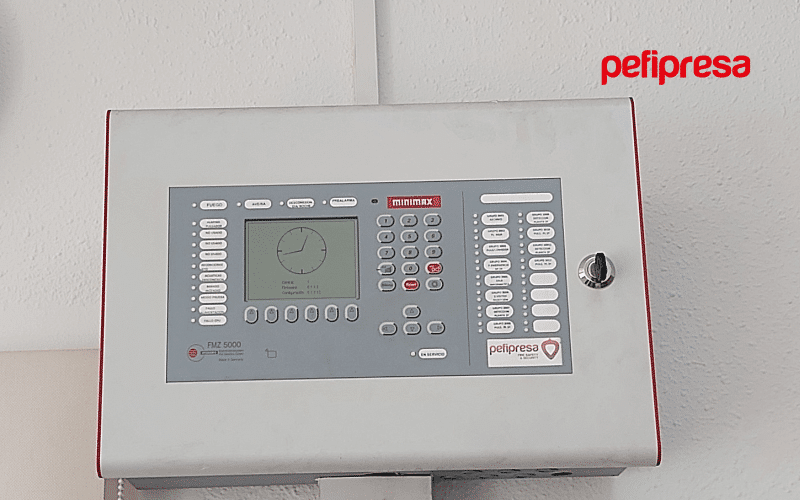
1- Central unit
The central unit of the fire detection system is the brain and essential element whose main function is communication with all the equipment in the system and the management of each one of them, collecting the signals from the different equipment field devices, such as detectors or push buttons and carrying out actions, depending on their programming, to activate other elements such as acoustic sirens or light signs, or sending signals or alarms to other systems.
It is the most important element of any detection system, without which the rest of the elements could not perform their work efficiently.
Among its multiple functions, it also includes continuous monitoring of the status of each connected device, so that if any of them stops working correctly due to a fault, it will be detected immediately and the corresponding warning will be produced in the control panel.
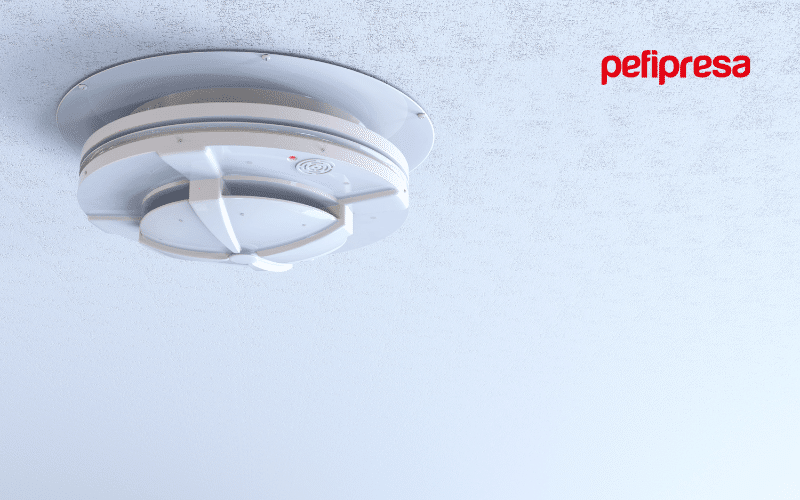
2- Automatic fire detectors
Fire detectors are those devices that, through different technologies, can monitor the level of smoke or temperature in a certain room so that, once the defined threshold is exceeded, they automatically communicate a pre-alarm or alarm situation to the fire station.
We can find different types of fire detectors, among which the following stand out:
- Smoke detectors:
- Optics
- Photoelectrics
- Ionics
- Aspiration
- Temperature detectors:
- Thermals
- Velocimetric Thermometers
- Flame detectors:
- Infrared
- Ultraviolet
- Combined IR+UV
- Infrared Linear Detectors
- Gas detectors
- Sensor cables or temperature sensor
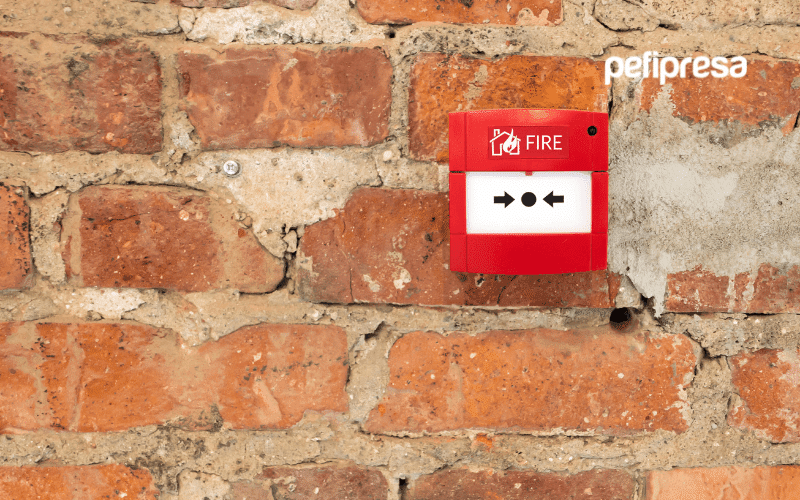
3- Manual pushbuttons
A manual fire alarm call point is a device used to communicate and initiate an alarm condition within a building fire detection system manually by a user who visually detects any outbreak or fire incipient and decide to act.
The most common type of manual fire alarm call point is an electromechanical device that activates by pressing the indicated place on the call point itself, which is normally partially covered by a methacrylate plate or similar material that is well it moves to pulsate or must be broken to do so.
The manual fire alarm pushbuttons are distributed throughout the installation as indicated by the regulations, complying with maximum travel distances from any point of the installation to the nearest pushbutton of up to 25 meters.
They are usually located close to the exits and must always be signposted on site with specific equipment.
4- Optical/acoustic warning devices
The optical and/or acoustic alarm devices have the function of emitting sound and/or lighting when they receive the signal from the fire panel due to a configured alarm condition, in order to both the control personnel or any authorized user of the installation can proceed to activate the extinction or communicate the evacuation of the building.
The most common alarm device and mandatory installation is the siren, which must emit at least an unequivocal sound and above the usual sound level of the room it protects, and can optionally have lighting optics either in the form of intermittent or continuous flash. They are called Visual Alarm Devices.
NOTE: Alarm devices whose component is visual are called VAD (Visual Alarm Device) and must specifically comply with the corresponding EN standard.
There are also lighting systems such as signs or warning lights that are also activated in the event of an alarm. They are called Alarm Indicator Devices.
5- Auxiliary control elements
In addition to the elements that we have discussed above, which are the essential elements of a fire detection system, there are other auxiliary devices that can initiate the activation of other systems, of a different nature, configured within the installation, always with the function of early extinction or maximum reduction of consequences in the event of a possible fire.
These auxiliary elements are called control modules and can be presented, depending on the manufacturer of the system, normally in elements with 1 input and/or 1 output, although there are combinations of several inputs and/or several outputs, as well as multiple or multiple inputs.
This equipment is typical of the fire installation and communicates with the control panel in the same way as detectors, pushbuttons or sirens, and can perform their output switching (in the case of output modules) at the request of the control panel before different situations, such as a pre-alarm or an alarm; or pick up an input event such as a valve stroke end.
The modules can command different systems, external to the fire detection installation itself, but which can be part of the global fire protection system, such as fire extinguishing equipment, or of other different systems.
Types of elements or actions controlled by the control modules of a fire detection system:
- Fire dampers
- Fire doors
- Curtains
- Acting in systems such as Air Conditioning or Electricity
- Sending signal to the Evacuation Public Address system
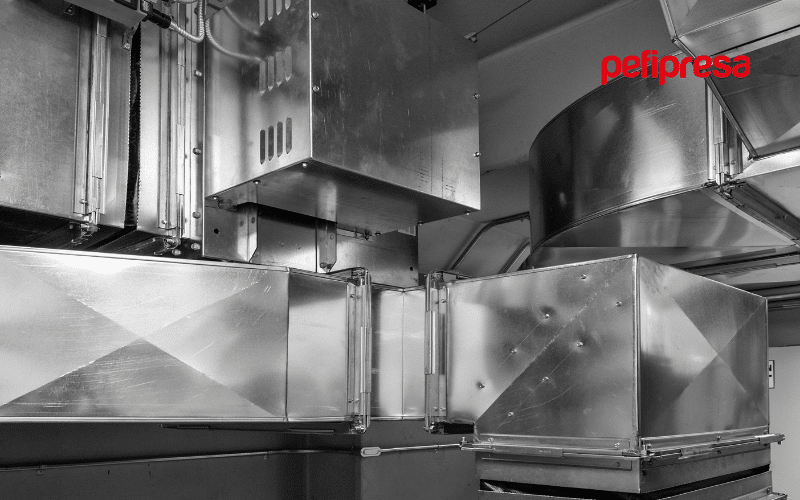
Types of electronic fire detection and alarm systems
Within the fire detection systems we can define 2 large groups, the fire detection systems with technology known generically as “conventional” and those known generically as “analog”.
What is a conventional fire detection system
The conventional fire detection system is the system in which its components work in zones, areas or groups, so that the alarm from a detector is interpreted by the control panel as an alarm in the zone or area it protects; that depending on its extension, it can be an area that covers one room or several.
They are the oldest and simplest systems, and they tend to disappear on a large scale due to the limitations in the control of the field teams and the scant information they provide, although there will continue to be very different types of installations. small ones where they can still dominate over more complex systems.
The biggest drawback of this system is that it is not capable of interpreting the exact location of the alarm, which is why they are cheaper systems and are intended for support or small-sized installations.
There are conventional addressable fire detection systems on the market, which are an evolution of traditional conventional systems but with the possibility of providing more information about the detector or the area that has raised the alarm.
What is an analog fire detection system
The analog electronic fire detection system is the most advanced system, in which each piece of equipment has its own address and which also incorporates configurable algorithms, such as pre-alarm and alarm thresholds, so that the control panel can perfectly distinguish the alarm from one detector or button to another, and consequently perfectly delimit the area or zone where the alarm has occurred.
Differences between analog and conventional fire detection system
Let’s see the most important differences between analog and conventional fire detection systems:
1- Distinction between detectors or buttons
The fundamental difference between an analogue detection system and a conventional one is the possibility of differentiating which detector has caused the alarm situation, in which the analogue system is capable of doing so, and yet the conventional system cannot since it works by zones or groups of detectors.
2- Complexity of the system and installation
Analog systems are much more complex, allowing greater configurations at performance and security levels, being able, for example, depending on the manufacturer, to raise or lower the pre-alarm or alarm thresholds through software.
3- Installation size
All large installations are covered with analog systems, being unfeasible for conventional systems, both due to the possibility of determining the exact location, and due to dimensioning, since analog systems may have more elements than conventional ones.
4- Representation in software and synoptics
There is also a difference in the representation on the screen using mimics, since a conventional system can indicate an alarm in the zone, but in an analogue one it is also possible to indicate which detector exactly has been activated, indicating it in the synoptic of the software in question, with the possibility of indicate it on a plane on the screen, with the corresponding ease of recognition for a control center and consequently greater speed of action.
5- Price
Economically there is a big difference between the cost of a conventional system with an analog one.
All the elements of the analogue system are technologically superior, which is why they are also more expensive than conventional ones by increasing the performance of the system.
In addition, although the installation is very similar, so the price does not vary, in terms of testing, configuration and start-up, analog systems require a longer amount of time due to their greater possibilities. programming and complexity of commissioning.
6- Maintenance and fault indication
Conventional systems do not allow remote maintenance to be carried out as they do not distinguish dirt or possible failure of a specific detector.
However, analog systems, depending on the model and manufacturer, can display in the control unit and its associated software, if any, the contamination levels of each detector individually, being able to anticipate their replacement and cleaning in a preventive manner , not once the element is damaged. This is especially important in remotely controlled systems.
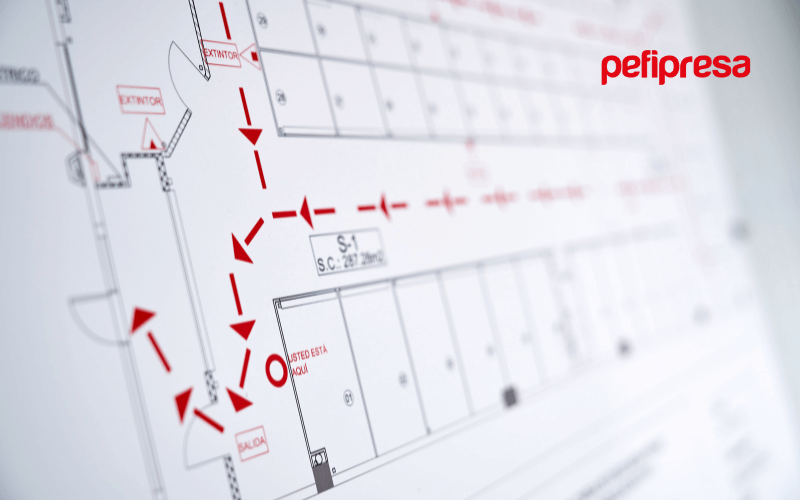
7- Integration in superior systems such as SCADA or PSIM
Regarding integration in control and supervision systems in buildings such as SCADA or PSIM, the capacity of an analogue system is infinitely greater in the vast majority of cases, being very limited in the case of conventional systems.
For example, in the event of an alarm from a detector in a room, it is possible to automate the triggering of the air extraction or turning off the lights, and for this it is necessary to know exactly which detector has caused the alarm.

